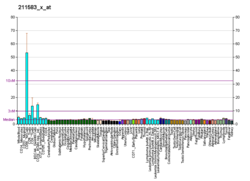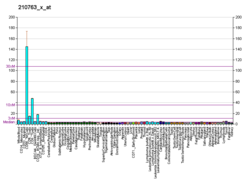NCR3
Appearance
Natural cytotoxicity triggering receptor 3 is a protein that in humans is encoded by the NCR3 gene.[3][4][5] NCR3 has also been designated as CD337 (cluster of differentiation 337) and as NKp30.
References
- ^ a b c ENSG00000236979, ENSG00000206430, ENSG00000237808, ENSG00000236315, ENSG00000223833, ENSG00000225211, ENSG00000204475 GRCh38: Ensembl release 89: ENSG00000237103, ENSG00000236979, ENSG00000206430, ENSG00000237808, ENSG00000236315, ENSG00000223833, ENSG00000225211, ENSG00000204475 – Ensembl, May 2017
- ^ "Human PubMed Reference:". National Center for Biotechnology Information, U.S. National Library of Medicine.
- ^ Nalabolu SR, Shukla H, Nallur G, Parimoo S, Weissman SM (Mar 1997). "Genes in a 220-kb region spanning the TNF cluster in human MHC". Genomics. 31 (2): 215–22. doi:10.1006/geno.1996.0034. PMID 8824804.
- ^ Sato M, Ohashi J, Tsuchiya N, Tadokoro K, Juji T, Hanaoka K, Tokunaga K, Yabe T (Jan 2002). "Identification of novel single nucleotide substitutions in the NKp30 gene expressed in human natural killer cells". Tissue Antigens. 58 (4): 255–8. doi:10.1034/j.1399-0039.2001.580406.x. PMID 11782277.
- ^ "Entrez Gene: NCR3 natural cytotoxicity triggering receptor 3".
Further reading
- Djeu JY, Jiang K, Wei S (2002). "A view to a kill: signals triggering cytotoxicity". Clin. Cancer Res. 8 (3): 636–40. PMID 11895890.
- Holzinger I, de Baey A, Messer G, et al. (1995). "Cloning and genomic characterization of LST1: a new gene in the human TNF region". Immunogenetics. 42 (5): 315–22. doi:10.1007/BF00179392. PMID 7590964. S2CID 19916860.
- de Baey A, Fellerhoff B, Maier S, et al. (1998). "Complex expression pattern of the TNF region gene LST1 through differential regulation, initiation, and alternative splicing". Genomics. 45 (3): 591–600. doi:10.1006/geno.1997.4963. PMID 9367684.
- Neville MJ, Campbell RD (1999). "A new member of the Ig superfamily and a V-ATPase G subunit are among the predicted products of novel genes close to the TNF locus in the human MHC". J. Immunol. 162 (8): 4745–54. PMID 10202016.
- Pende D, Parolini S, Pessino A, et al. (1999). "Identification and Molecular Characterization of Nkp30, a Novel Triggering Receptor Involved in Natural Cytotoxicity Mediated by Human Natural Killer Cells". J. Exp. Med. 190 (10): 1505–16. doi:10.1084/jem.190.10.1505. PMC 2195691. PMID 10562324.
- Sivakamasundari R, Raghunathan A, Zhang CY, et al. (2000). "Expression and cellular localization of the protein encoded by the 1C7 gene: a recently described component of the MHC". Immunogenetics. 51 (8–9): 723–32. doi:10.1007/s002510000192. PMID 10941844. S2CID 27714493.
- Strausberg RL, Feingold EA, Grouse LH, et al. (2003). "Generation and initial analysis of more than 15,000 full-length human and mouse cDNA sequences". Proc. Natl. Acad. Sci. U.S.A. 99 (26): 16899–903. Bibcode:2002PNAS...9916899M. doi:10.1073/pnas.242603899. PMC 139241. PMID 12477932.
- Le Bouteiller P, Barakonyi A, Giustiniani J, et al. (2003). "Engagement of CD160 receptor by HLA-C is a triggering mechanism used by circulating natural killer (NK) cells to mediate cytotoxicity". Proc. Natl. Acad. Sci. U.S.A. 99 (26): 16963–8. doi:10.1073/pnas.012681099. PMC 139252. PMID 12486241.
- Augugliaro R, Parolini S, Castriconi R, et al. (2003). "Selective cross-talk among natural cytotoxicity receptors in human natural killer cells". Eur. J. Immunol. 33 (5): 1235–41. doi:10.1002/eji.200323896. PMID 12731048. S2CID 10724743.
- Mungall AJ, Palmer SA, Sims SK, et al. (2003). "The DNA sequence and analysis of human chromosome 6". Nature. 425 (6960): 805–11. Bibcode:2003Natur.425..805M. doi:10.1038/nature02055. PMID 14574404.
- Marcenaro E, Augugliaro R, Falco M, et al. (2004). "CD59 is physically and functionally associated with natural cytotoxicity receptors and activates human NK cell-mediated cytotoxicity". Eur. J. Immunol. 33 (12): 3367–76. doi:10.1002/eji.200324425. PMID 14635045. S2CID 40345630.
- Xie T, Rowen L, Aguado B, et al. (2004). "Analysis of the Gene-Dense Major Histocompatibility Complex Class III Region and Its Comparison to Mouse". Genome Res. 13 (12): 2621–36. doi:10.1101/gr.1736803. PMC 403804. PMID 14656967.
- Gerhard DS, Wagner L, Feingold EA, et al. (2004). "The Status, Quality, and Expansion of the NIH Full-Length cDNA Project: The Mammalian Gene Collection (MGC)". Genome Res. 14 (10B): 2121–7. doi:10.1101/gr.2596504. PMC 528928. PMID 15489334.
- Nowbakht P, Ionescu MC, Rohner A, et al. (2005). "Ligands for natural killer cell-activating receptors are expressed upon the maturation of normal myelomonocytic cells but at low levels in acute myeloid leukemias". Blood. 105 (9): 3615–22. doi:10.1182/blood-2004-07-2585. PMID 15657183.
- Poggi A, Massaro AM, Negrini S, et al. (2005). "Tumor-induced apoptosis of human IL-2-activated NK cells: role of natural cytotoxicity receptors". J. Immunol. 174 (5): 2653–60. doi:10.4049/jimmunol.174.5.2653. PMID 15728472.
- Vitale M, Della Chiesa M, Carlomagno S, et al. (2005). "NK-dependent DC maturation is mediated by TNFalpha and IFNgamma released upon engagement of the NKp30 triggering receptor". Blood. 106 (2): 566–71. doi:10.1182/blood-2004-10-4035. PMID 15784725.
- Warren HS, Jones AL, Freeman C, et al. (2005). "Evidence that the cellular ligand for the human NK cell activation receptor NKp30 is not a heparan sulfate glycosaminoglycan". J. Immunol. 175 (1): 207–12. doi:10.4049/jimmunol.175.1.207. PMID 15972650.
- Joyce MG, Gordon M, Tran P, et al. (2011). "Crystal structure of human natural cytotoxicity receptor NKp30 and identification of its ligand binding site". PNAS. 108 (15): 6223–6228. Bibcode:2011PNAS..108.6223J. doi:10.1073/pnas.1100622108. PMC 3076882. PMID 21444796.
External links
- NCR3+protein,+human at the U.S. National Library of Medicine Medical Subject Headings (MeSH)
- PDBe-KB provides an overview of all the structure information available in the PDB for Human Natural cytotoxicity triggering receptor 3 (NCR3)
This article incorporates text from the United States National Library of Medicine, which is in the public domain.





